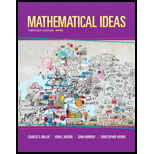
Mathematical Ideas (13th Edition) - Standalone book
13th Edition
ISBN: 9780321977076
Author: Charles D. Miller, Vern E. Heeren, John Hornsby, Christopher Heeren
Publisher: PEARSON
expand_more
expand_more
format_list_bulleted
Concept explainers
Textbook Question
Chapter 15.4, Problem 26E
The Jefferson and Adams methods are both subject to quota rule violations. But when violations do occur, one of these methods always apportions too many seats, and the other always apportions too few seats. Which is which?
Expert Solution & Answer
Want to see the full answer?
Check out a sample textbook solution
Students have asked these similar questions
Problem:Allocate 25 seats for five states whose populations are 12576, 13146, 14105, 13578, and 12986 respectively using
The Adams Method
Correct Suppose a software company wants to form a new 36-person committee for a new project. There are 136 employees in the sales department, 103 employees in the development department, and 174 in the design department. Use the Huntington-Hill method to determine the allocation of committee members based on department size.
Which one of the apportionment methods studied does not violate the quota rule?
Group of answer choices
Hamilton's Method
Jefferson's Method
Adam's Method
Webster's Method
Chapter 15 Solutions
Mathematical Ideas (13th Edition) - Standalone book
Ch. 15.1 - Choosing a Poster Dog by the Plurality Method A...Ch. 15.1 - Choosing a Poster Dog by the Plurality Method A...Ch. 15.1 - Choosing a Poster Dog by Alternative Methods For...Ch. 15.1 - Choosing a Poster Dog by Alternative MethodsFor...Ch. 15.1 - Observing the Effect of the Number of Candidates...Ch. 15.1 - Observing the Effect of the Number of Candidates...Ch. 15.1 - Observing the Effect of the Number of Candidates...Ch. 15.1 - Observing the Effect of the Number of Candidates...Ch. 15.1 - Observing the Effect of the Number of Candidates...Ch. 15.1 - Observing the Effect of the Number of Candidates...
Ch. 15.1 - Applying Four Voting Methods to a Voter Profile...Ch. 15.1 - Applying Four Voting Methods to a Voter Profile...Ch. 15.1 - Applying Four Voting Methods to a Voter Profile...Ch. 15.1 - Applying Four Voting Methods to a Voter Profile...Ch. 15.1 - Applying Four Voting Methods to a Voter Profile...Ch. 15.1 - Applying Four Voting Methods to a Voter Profile...Ch. 15.1 - Applying Four Voting Methods to a Voter Profile...Ch. 15.1 - Applying Four Voting Methods to a Voter Profile...Ch. 15.1 - Holding a Runoff Election One common solution to...Ch. 15.1 - Prob. 20ECh. 15.1 - Prob. 21ECh. 15.1 - Prob. 22ECh. 15.1 - Prob. 23ECh. 15.1 - Prob. 24ECh. 15.1 - Prob. 25ECh. 15.1 - Prob. 26ECh. 15.1 - Prob. 27ECh. 15.1 - The Pairwise Comparison Method Each table...Ch. 15.1 - Prob. 29ECh. 15.1 - Prob. 30ECh. 15.1 - The Borda Method Each table represents a Borda...Ch. 15.1 - Prob. 32ECh. 15.1 - Prob. 33ECh. 15.1 - Prob. 34ECh. 15.1 - Prob. 35ECh. 15.1 - Prob. 36ECh. 15.1 - The Coombs Method The Coombs method of voting is a...Ch. 15.1 - Prob. 38ECh. 15.1 - Prob. 39ECh. 15.1 - Prob. 40ECh. 15.2 - Identifying Violations of the Majority Criterion...Ch. 15.2 - Identifying Violations of the Majority Criterion...Ch. 15.2 - Identifying Violations of the Majority...Ch. 15.2 - Identifying Violations of the Majority Criterion...Ch. 15.2 - Identifying Violations of the Condorcet...Ch. 15.2 - Identifying Violations of the Condorcet Criterion...Ch. 15.2 - Identifying Violations of the Condorcet Criterion...Ch. 15.2 - Identifying Violations of the Condorcet Criterion...Ch. 15.2 - Prob. 9ECh. 15.2 - Prob. 10ECh. 15.2 - Prob. 11ECh. 15.2 - Prob. 12ECh. 15.2 - Prob. 13ECh. 15.2 - Prob. 14ECh. 15.2 - Prob. 15ECh. 15.2 - Prob. 16ECh. 15.2 - Prob. 17ECh. 15.2 - Prob. 18ECh. 15.2 - Prob. 19ECh. 15.2 - Irrelevant Alternatives in a Hare Method Election...Ch. 15.2 - 21. Explain why a violation of the majority...Ch. 15.2 - Prob. 22ECh. 15.2 - Prob. 23ECh. 15.2 - Prob. 24ECh. 15.2 - Prob. 25ECh. 15.2 - Prob. 26ECh. 15.2 - Prob. 27ECh. 15.2 - Prob. 28ECh. 15.2 - Prob. 29ECh. 15.2 - Prob. 30ECh. 15.2 - Prob. 31ECh. 15.2 - Prob. 32ECh. 15.2 - Prob. 33ECh. 15.2 - Prob. 34ECh. 15.3 - Find each quantity (to the nearest whole number)...Ch. 15.3 - Find each quantity (to the nearest whole number)...Ch. 15.3 - Find each quantity (to the nearest whole number)...Ch. 15.3 - Find each quantity (to the nearest whole number)...Ch. 15.3 - Solve each problem.
5. New Trees for Wisconsin...Ch. 15.3 - Apportioning Computers to Schools Enrollments for...Ch. 15.3 - Assigning Faculty to Courses The English...Ch. 15.3 - 8. Apportioning Sailboats to Resorts The number of...Ch. 15.3 - Prob. 9ECh. 15.3 - 10. Show that the Webster method apportionment of...Ch. 15.3 - Prob. 11ECh. 15.3 - Prob. 12ECh. 15.3 - Prob. 13ECh. 15.3 - Prob. 14ECh. 15.3 - Prob. 15ECh. 15.3 - Find the Huntington-Hill cutoff point for rounding...Ch. 15.3 - Creating a Profile of School Bus Riders Create a...Ch. 15.3 - Prob. 18ECh. 15.3 - Prob. 19ECh. 15.3 - Prob. 20ECh. 15.3 - The standard quotas rounded up to the nearest...Ch. 15.3 - Prob. 22ECh. 15.3 - Prob. 23ECh. 15.3 - Prob. 24ECh. 15.4 - Quota Rule Violations with the Jefferson Method In...Ch. 15.4 - Quota Rule Violations with the Jefferson Method In...Ch. 15.4 - Quota Rule Violations with the Jefferson Method In...Ch. 15.4 - Quota Rule Violations with the Jefferson Method In...Ch. 15.4 - Alabama Paradox with the Hamilton Method In each...Ch. 15.4 - Alabama Paradox with the Hamilton Method In each...Ch. 15.4 - Alabama Paradox with the Hamilton Method In each...Ch. 15.4 - Alabama Paradox with the Hamilton Method In each...Ch. 15.4 - Population Paradox with the Hamilton Method In...Ch. 15.4 - Population Paradox with the Hamilton Method In...Ch. 15.4 - Population Paradox with the Hamilton Method In...Ch. 15.4 - Population Paradox with the Hamilton Method In...Ch. 15.4 - New States Paradox with the Hamilton Method In...Ch. 15.4 - New States Paradox with the Hamilton Method In...Ch. 15.4 - New States Paradox with the Hamilton Method In...Ch. 15.4 - New States Paradox with the Hamilton Method In...Ch. 15.4 - Violations of the Quota Rule? For each...Ch. 15.4 - Violations of the Quota Rule? For each...Ch. 15.4 - Violations of the Quota Rule? For each...Ch. 15.4 - Prob. 20ECh. 15.4 - Prob. 21ECh. 15.4 - Prob. 22ECh. 15.4 - Prob. 23ECh. 15.4 - Prob. 24ECh. 15.4 - Prob. 25ECh. 15.4 - 26. The Jefferson and Adams methods are both...Ch. 15 - How many different complete rankings are possible...Ch. 15 - Prob. 2TCh. 15 - Prob. 3TCh. 15 - Prob. 4TCh. 15 - Prob. 5TCh. 15 - Why is the irrelevant alternatives criterion an...Ch. 15 - Prob. 7TCh. 15 - Prob. 8TCh. 15 - Prob. 9TCh. 15 - Prob. 10TCh. 15 - Prob. 11TCh. 15 - Prob. 12TCh. 15 - Prob. 13TCh. 15 - Prob. 14TCh. 15 - Prob. 15TCh. 15 - Prob. 16TCh. 15 - Prob. 17TCh. 15 - Prob. 18TCh. 15 - Prob. 19TCh. 15 - Prob. 20TCh. 15 - Prob. 21TCh. 15 - Prob. 22TCh. 15 - Prob. 23TCh. 15 - Prob. 24TCh. 15 - Prob. 25TCh. 15 - One hundred seats are to be apportioned to 4...Ch. 15 - Prob. 27TCh. 15 - Prob. 28TCh. 15 - Prob. 29TCh. 15 - Explain the Alabama paradox.Ch. 15 - Prob. 31TCh. 15 - Prob. 32T
Knowledge Booster
Learn more about
Need a deep-dive on the concept behind this application? Look no further. Learn more about this topic, subject and related others by exploring similar questions and additional content below.Similar questions
- A Father of four children plans to distribute 40 ampao among his children based on the hours they study their subjects. If he uses the Hamilton method, what will be the fairway to divide the ampao? Child 1 Child 2 Child 3 child 4 Total Minutes worked 40 50 170 20 280 Standard Quota Lower Quota Final apportionment Allocationarrow_forwardConsider the apportionment of 60 doctors for a physicians organization. The apportionment using Hamilton's method is shown in the table below. Does the Alabama paradox occur using Hamilton's method if the number of doctors is increased from 60 to 61? Clinic A B C D E Total Patients 656 536 515 549 602 2858 Standard quota 13.77 11.25 10.81 11.53 12.64 60.00 Lower quota 13 11 10 11 12 57 Hamilton's apportionment 14 11 11 11 13 60 Complete the table below with the new apportionment for clinics A, B, C, D, and E using a standard divisor rounded to two decimal places. Clinic A B C D E Total Patients 656 536 515 549 602 2858 Hamilton's apportionment ? ? ? ? ? 61arrow_forwardA small country consists of three states, whose populations are listed below.A: 6,000 B: 6,000 C: 2,000a. If the legislature has 10 seats, use Hamilton’s method to apportion the seats.b. If the legislature grows to 11 seats, use Hamilton’s method to apportion the seats.c. Which apportionment paradox does this illustrate?arrow_forward
- A vote is to be taken among the residents of a town and the surrounding county to determine whether a proposed chemical plant should be constructed. The construction site is within the town limits, and for this reason many voters in the county believe that the proposal will pass because of the large proportion of town voters who favor the construction. To determine if there is a significant difference in the proportions of town voters and county voters favoring the proposal, a poll is taken. If 120 of 200 town voters favor the proposal and 240 of 500 county residents favor it, would you agree that the proportion of town voters favoring the proposal is higher than the proportion of county voters? Use an α = 0.05 level of significance.arrow_forwardA state highway commission is considering removing the lane that allows people to pay cash for a toll on a toll road and requiring all people who use the toll road to pay with an electronic transponder that is connected to their car. The commission wants to know whether the proportion of people who live in the northern part of the state and are in favor of removing the cash lane is different from the proportion of people who live in the southern part of the state and are in favor of removing the cash lane. Independent random samples are selected from the northern and southern parts of the state. The table summarizes the responses of those surveyed. Northern Southern Total Remove Cash Lanes 112 98 210 Keep Cash Lanes 89 105 194 Total 201 203 404 Which of the following is closest to the pp-value of the appropriate test to investigate whether the proportion of people living in the northern part of the state who are in favor of removing the cash lane is different from…arrow_forwardProblem:Allocate 25 seats for five states whose populations are 12576, 13146, 14105, 13578, and 12986 respectively using 1. The Hamilton Method 2. The Adams Method 3. The Huntington-Hill Methodarrow_forward
- Economist Arthur Laffer suggests that beyond a certain point, high tax rates depress the economy so much that they actually reduce tax revenues. He proposed tax reductions as a means of stimulating the economy and, as a result, increase tax revenues. In the mid 1990’s Time magazine reported that 30% of the US Congress supported a tax cut as a means of stimulating the economy and increasing tax revenues. Suppose at that time 5 members of congress were randomly selected for an interview and asked whether they supported a tax cut to stimulate the economy. 1.2) Find the probability that at least three of the five members of congress who were interviewed were in favour of a tax cut (rounded off to four decimals).arrow_forwardA vote is to be taken among the residents of a town and the surrounding county to determine whether a proposed chemical plant should be constructed. The construction site is within the town limits, and for this reason many voters in the county believe that the proposal will pass because of the large proportion of town voters who favor the construction. To determine if there is a significant difference in the proportions of town voters and county voters favoring the proposal, a poll is taken. If 120 out of 200 town voters favor the proposal and 240 out of 500 county voters favor it, would you agree that the proportion of town voters favoring the proposal is higher than the proportion of county voters? Use an alpha = 0.01 level of significance.arrow_forwardForty-eight percent of all California registered voters prefer life in prison without parole over the death penalty for a person convicted of first-degree murder. Among Latino California registered voters, 55% prefer life in prison without parole over the death penalty for a person convicted of first-degree murder. 37.6% of all Californians are Latino.In this problem, let: • C = Californians (registered voters) preferring life in prison without parole over the death penalty for a person convicted of first-degree murder.• L = Latino Californians 7. Are L and C independent events? Show why or why not.8. Find P(L OR C). Explain your response.arrow_forward
arrow_back_ios
arrow_forward_ios
Recommended textbooks for you
 Discrete Mathematics and Its Applications ( 8th I...MathISBN:9781259676512Author:Kenneth H RosenPublisher:McGraw-Hill Education
Discrete Mathematics and Its Applications ( 8th I...MathISBN:9781259676512Author:Kenneth H RosenPublisher:McGraw-Hill Education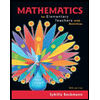 Mathematics for Elementary Teachers with Activiti...MathISBN:9780134392790Author:Beckmann, SybillaPublisher:PEARSON
Mathematics for Elementary Teachers with Activiti...MathISBN:9780134392790Author:Beckmann, SybillaPublisher:PEARSON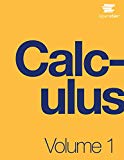
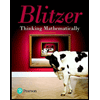 Thinking Mathematically (7th Edition)MathISBN:9780134683713Author:Robert F. BlitzerPublisher:PEARSON
Thinking Mathematically (7th Edition)MathISBN:9780134683713Author:Robert F. BlitzerPublisher:PEARSON Discrete Mathematics With ApplicationsMathISBN:9781337694193Author:EPP, Susanna S.Publisher:Cengage Learning,
Discrete Mathematics With ApplicationsMathISBN:9781337694193Author:EPP, Susanna S.Publisher:Cengage Learning,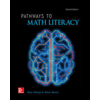 Pathways To Math Literacy (looseleaf)MathISBN:9781259985607Author:David Sobecki Professor, Brian A. MercerPublisher:McGraw-Hill Education
Pathways To Math Literacy (looseleaf)MathISBN:9781259985607Author:David Sobecki Professor, Brian A. MercerPublisher:McGraw-Hill Education

Discrete Mathematics and Its Applications ( 8th I...
Math
ISBN:9781259676512
Author:Kenneth H Rosen
Publisher:McGraw-Hill Education

Mathematics for Elementary Teachers with Activiti...
Math
ISBN:9780134392790
Author:Beckmann, Sybilla
Publisher:PEARSON


Thinking Mathematically (7th Edition)
Math
ISBN:9780134683713
Author:Robert F. Blitzer
Publisher:PEARSON

Discrete Mathematics With Applications
Math
ISBN:9781337694193
Author:EPP, Susanna S.
Publisher:Cengage Learning,

Pathways To Math Literacy (looseleaf)
Math
ISBN:9781259985607
Author:David Sobecki Professor, Brian A. Mercer
Publisher:McGraw-Hill Education
Propositional Logic, Propositional Variables & Compound Propositions; Author: Neso Academy;https://www.youtube.com/watch?v=Ib5njCwNMdk;License: Standard YouTube License, CC-BY
Propositional Logic - Discrete math; Author: Charles Edeki - Math Computer Science Programming;https://www.youtube.com/watch?v=rL_8y2v1Guw;License: Standard YouTube License, CC-BY
DM-12-Propositional Logic-Basics; Author: GATEBOOK VIDEO LECTURES;https://www.youtube.com/watch?v=pzUBrJLIESU;License: Standard Youtube License
Lecture 1 - Propositional Logic; Author: nptelhrd;https://www.youtube.com/watch?v=xlUFkMKSB3Y;License: Standard YouTube License, CC-BY
MFCS unit-1 || Part:1 || JNTU || Well formed formula || propositional calculus || truth tables; Author: Learn with Smily;https://www.youtube.com/watch?v=XV15Q4mCcHc;License: Standard YouTube License, CC-BY